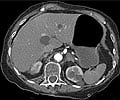Nationally, smoking rates have decreased since 1996, but the declines have been driven by a relatively small share of counties across the US.

The study, "Cigarette smoking prevalence in US counties: 1996-2012," was published March 24 in the open-access, peer-reviewed journal Population Health Metrics.
Total cigarette smoking prevalence – the percentage of the population that smokes – has not decreased significantly in all counties but, because a small group of counties accounts for a large percentage of the population, three-quarters of men and two-thirds of women live in counties that did see significant declines.
Most of the decline in smoking rates has occurred within the past decade. Nationally, smoking rates have declined for men from 27.3% to 22.2%, and for women from 22.2% to 17.9% between 1996 and 2012. In individual counties there were much bigger gains.
Annualized rate of change captures the pace of change in smoking rates between 1996 and 2012. The greatest decline in smoking rates for men was 4.5% per year in Falls Church City, Virginia, and the largest increase for men was 1.1% per year in Issaquena County, Mississippi. The greatest decline in smoking rates for women was 4.1% per year in Maverick County, Texas, and the greatest increase for women was 1.7% per year in McMullen County, Texas.
"We know what works in tobacco control. It's taxation. It's smoking bans. It's advertising bans, among other measures," said IHME Director Dr. Christopher Murray. "We now need to understand what is happening on the ground in these counties that is leading to such great success in parts of New York, Iowa, and Texas, and near total stagnation in parts of Montana, Oklahoma, and Mississippi."
Advertisement
Overall, counties in the South, particularly in Kentucky, Tennessee, and West Virginia, as well as those with large Native American populations, have the highest rates of total cigarette smoking, while counties in Utah and other Western states have the lowest.
Advertisement
High smoking rates for women were found in southern states, including Kentucky, West Virginia, Tennessee, Missouri, Oklahoma, Arkansas, and Louisiana. Female smoking rates also were high in parts of Alaska, Nevada, Arizona, North Dakota, and South Dakota. Counties with the lowest rates of smoking for women were found in Utah, Colorado, Wyoming, California, and the area along the Mexico-Texas border.
Out of all counties in the US, men in Falls Church City, Virginia, had the lowest total cigarette smoking prevalence in 2012, at 9.9%, and men in Northwest Arctic Borough, Alaska, had the highest at 41.5%. For women, smoking rates were lowest in Utah County, Utah, at 5.8%, and highest in Northwest Arctic Borough, Alaska, at 40.8%.
Smoking rates vary dramatically between counties and even within states.
For men, Virginia had the largest gap in the highest and lowest smoking rates among counties: a 23.6 percentage point difference between men in Falls Church City (9.9%) and their counterparts in Sussex County (33.5%). Alaska was the state with the largest gap for women, a 25.4 percentage point difference between Haines Borough (15.4%) and Northwest Arctic Borough (40.8%).
"What we are seeing with gaps in smoking rates is very similar to what we have seen with gaps in life expectancy between counties," said Dr. Ali Mokdad, Professor of Global Health at IHME and one of the study authors. "It should not be the case that in one county in Virginia less than 10 percent of people smoke while nearby a full third do. And it shouldn't be the case that people are living more than a decade longer in some counties than in others."
Evaluating smoking rates at the county level provides a more detailed picture of which communities have made progress on tobacco control and which ones are falling behind. While state-level policies may not be implemented or enforced evenly across all jurisdictions, local jurisdictions have the ability to implement their own tobacco control policies and programs.
According to the most recent figures from the Global Burden of Disease (GBD) study, coordinated by IHME, tobacco smoking was linked to 465,000 deaths and 12% of total health loss in the US. Globally, tobacco led to 5.7 million deaths and 5.5% of total health loss. These estimates exclude the effects of secondhand smoke. Although it's been 50 years since the first US Surgeon General's report on the negative health impact of smoking, some counties in the US have higher smoking rates than certain countries around the world.
For women, nearly half of all the countries in the world, including Indonesia and Saudi Arabia, have lower daily smoking prevalence than any county in the US. At the same time, only 1.6% of countries have higher female daily smoking prevalence than any county in the US.
Many of the counties with the lowest smoking rates for women are in Utah, ranging from 9.1% to 5.8%. And yet, daily smoking prevalence for women in 2012 was even lower in countries such as India and Thailand.
It continues to be true that men smoke at higher rates than women nearly everywhere you go in the U.S. In the vast majority of counties, men smoked cigarettes at higher rates than women.
That was true in 99% of counties in 1996 and 96.4% of counties in 2012. The researchers also broke down the findings by income group. They found that those who live in counties with higher incomes tended to smoke a lot less over time than those living in counties with lower incomes. In the top income group, 75% of counties saw a statistically significant decline in male smoking from 1996 to 2012, compared to 14% of counties in the bottom income group. For women, 45% of the counties in the top income group saw significant smoking declines, while only 4% of counties in the bottom income group had significant declines.
"We know that there is a very strong relationship between poverty and people's health," said the study's lead author, Laura Dwyer-Lindgren. "We need to better understand how to break that connection between poverty and health outcomes, not only with smoking but with a range of risk factors."
Which counties had the highest and lowest total cigarette smoking prevalence for men in 2012?
Lowest: Falls Church City, VA 9.9%
Utah County, UT 9.9%
Davis County, UT 11.7%
Wasatch County, UT 11.8%
Arlington County, VA 11.8%
Summit County, UT 12.5%
Howard County, MD 12.7%
Whitman County, WA 12.8%
Cache County, UT 12.8%
Loudoun County, VA 13.1%
Highest: Northwest Arctic Borough, AK 41.5%
Wade Hampton, AK 41.2%
Nome Census Area, AK 38.1%
Shannon County, SD 37.9%
Sioux County, ND 37.7%
Bethel Census Area, AK 37.5%
Lee County, KY 37.4%
Clay County, KY 37.2%
East Carroll Parish, LA 37%
Issaquena County, MS 36.8%
Which counties had the highest and lowest total cigarette smoking prevalence for women in 2012?
Lowest: Utah County, UT 5.8%
Wasatch County, UT 7.1%
Davis County, UT 8.3%
Hidalgo County, TX 8.6%
San Mateo County, CA 8.7%
Cameron County, TX 8.8%
Summit County, UT 8.9%
Santa Clara County, CA 9%
Cache County, UT 9.1%
Los Angeles County, CA 9.6%
Highest: Northwest Arctic Borough, AK 40.8%
North Slope Borough, AK 37.5%
Menominee County, WI 36.5%
Clay County, KY 36.2%
Wade Hampton, AK 36.2%
Nome Census Area, AK 35.8%
Buffalo County, SD 35.4%
Knox County, KY 34.7%
Shannon County, SD 34.1%
Elliott County, KY 34%
For men, which counties had the fastest declines and the biggest annual increases in total cigarette smoking prevalence between 1996 and 2012?
Decreases: Falls Church City, VA -4.5%
Arlington County, VA -3.2%
San Francisco County, CA -3.1%
Loudoun County, VA -2.9%
New York County, NY -2.8%
Orange County, CA -2.8%
Dallas County, IA -2.8%
Rockingham County, NH -2.8%
San Mateo County, CA -2.8%
Utah County, UT -2.8%
Increases: Issaquena County, MS 1.1%
Meagher County, MT 0.9%
Bent County, CO 0.8%
Hardy County, WV 0.7%
East Carroll Parish, LA 0.7%
Wheeler County, GA 0.6%
Benson County, ND 0.5%
Claiborne County, MS 0.5%
Lee County, AR 0.5%
Lincoln County, AR 0.4%
For women, which counties had the fastest declines and the biggest annual increases in total cigarette smoking prevalence between 1996 and 2012?
Decreases: Maverick County, TX -4.1%
Hidalgo County, TX -3.7%
San Luis Obispo County, CA -3.7%
Falls Church City, VA -3.7%
Webb County, TX -3.6%
Santa Barbara County, CA -3.5%
San Francisco County, CA -3.5%
San Mateo County, CA -3.4%
Wasatch County, UT -3.4%
Chittenden County, VT -3.3%
Increases: McMullen County, TX 1.7%
Mineral County, WV 1.6%
Muskogee County, OK 1.4%
Allen Parish, LA 1.4%
Bristol City, VA 1.4%
Benson County, ND 1.3%
Grant County, WV 1.2%
Hampshire County, WV 1.2%
Adair County, OK 1.2%
Sullivan County, TN 1.2%
Source-Eurekalert















